Life after retirement for Hubble hardware
Two pieces of 'retired' hardware retrieved from the Hubble Space Telescope provide scientists and engineers with unique knowledge of how long-term exposure to the harsh space environment affects hardware.
In March 2002, during a Space Shuttle servicing mission, the European-built Faint Object Camera (FOC) and a set of solar arrays were retrieved from the NASA/ESA Hubble Space Telescope and brought back to Earth. Since most of the hardware sent into space never reaches the ground again in one piece, engineers and scientists were eager to examine everything as soon after the landing as possible.
Samples of the FOC and the solar arrays were taken directly from the cargo bay of the Space Shuttle after only a few hours - before they were 'contaminated' by our atmosphere. Samples should be as unspoilt as possible for the laboratory investigations that will take place over the coming months.

The results of the detailed investigations of the Hubble FOC and arrays are not expected before the end of next year. However, visual inspection has already revealed some of the state of the hardware.
Despite its record 4340-day stay in space, the FOC instrument shows no signs of degradation. "It looks like new!" says Lothar Gerlach, ESA's solar generator specialist and central person in the 'post-flight activities'.
"The solar arrays also look great," he says, "but have the typical signs of being exposed to the extreme temperatures, intense radiation and micrometeorite bombardment in space." Typical signs would include cracks, holes, and discolouring in the solar arrays, for example.
Even though Hubble's FOC and solar arrays no longer play an active role, they have received a new 'life' back on Earth. They will provide material scientists and space-debris researchers with a rare opportunity to examine the effects of long-term operations in space.

The Hubble Space Telescope is a project of international co-operation between ESA and NASA.
Scientists all over the world continue to use the thousands of FOC images stored in archives in Europe, the USA and Canada.






